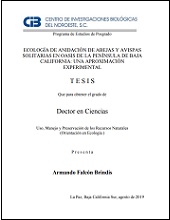| dc.contributor.advisor | JIMENEZ JIMENEZ, MARIA LUISA | |
| dc.contributor.advisor | RODRIGUEZ ESTRELLA, RICARDO | |
| dc.contributor.author | FALCON BRINDIS, ARMANDO | |
| dc.date.issued | 2019 | |
| dc.identifier.uri | http://dspace.cibnor.mx:8080/handle/123456789/2983 | |
| dc.description.abstract | "Los oasis de la península de Baja California (PBC) en México, se consideran hotspots para la biodiversidad. Estos hábitats mésicos ofrecen alimento y refugio a un gran número de especies en medio de las condiciones xéricas presentes en la PBC. Sin embargo, aún se desconocen una gran cantidad de interacciones biológicas en los oasis y su conexión con la zona desértica en la que están inmersos, especialmente las relaciones entre grupos clave como son las abejas y avispas (Hymenoptera). Estos insectos ofrecen servicios ambientales vitales para el funcionamiento de los ecosistemas. Es de particular preocupación que las actividades humanas están provocando fragmentación y pérdida de hábitat, lo cual está afectando negativamente a las poblaciones y comunidades de estos insectos. En este trabajo, se estudiaron las comunidades de abejas y avispas que anidan en cavidades preexistentes en seis oasis de la PBC. Se evaluaron efectos biogeográficos, climáticos, de hábitat (oasis-desierto) y nivel de disturbio humano sobre la riqueza y abundancia de abejas, avispas y sus enemigos naturales en seis oasis y su respectiva zona desértica circundante. Se utilizaron modelos lineales generales mixtos (GLMM) para identificar las variables que explican la abundancia de las especies, así como análisis de diversidad bajo las distintas condiciones hábitat (oasis-desierto) y nivel de disturbio humano. En total se encontraron 40 especies ocupando los nidos artificiales, las cuales incluyeron a los órdenes: Hymenoptera (33 especies), Diptera (5), Lepidoptera (1) y Coleoptera (1). La abundancia de nidos varió entre abejas y avispas, pero la radiación solar (GLMMabejas=3.83, g.l.=1, p<0.01; GLMMavispas=3.17, g.l.=1, p=0.01) y la humedad relativa (GLMMabejas=3.74, g.l.=1, p=0.002; GLMMavispas=4.99, g.l.=1, p<0.01) influyeron sobre la abundancia de ambos grupos. El 60% de la anidación de ambos grupos ocurrió en los oasis y dentro de un radio de 350 m respecto al cuerpo de agua. En general, la abundancia y riqueza fueron mayores dentro de los oasis (χ21 = 18.7, p<0.01). Las abejas no discriminaron entre oasis y desierto para anidar (χ21 = 0.028, p=0.866). En contraste, las avispas mostraron una alta dependencia hacia los oasis (χ21 = 38.5, p<0.01). No obstante, hubo excepciones en ambos grupos. La diversidad de especies fue significativamente mayor en los oasis (t = 4.95, g.l. = 324, p<0.001) y en sitios con nivel de disturbio bajo (t = 4.12, g.l. = 316.8, p<0.001)..." | es |
| dc.format | pdf | es |
| dc.language.iso | spa | es |
| dc.publisher | Centro de Investigaciones Biológicas del Noroeste, S.C. | es |
| dc.rights | Acceso abierto | es |
| dc.subject | abejas, avispas, desierto sonorense, nidos trampa, polinizadores | es |
| dc.subject | bees, wasps, Sonoran desert, trap nests, pollinators | es |
| dc.subject.classification | ECOLOGÍA DE LOS INSECTOS | es |
| dc.title | Ecología de anidación de abejas y avispas solitarias en oasis de la península de Baja California: una aproximación experimental | es |
| dc.type | doctoralThesis | es |
| dc.dirtesis.grado | Doctorado en Ciencias en el Uso, Manejo y Preservación de los Recursos Naturales | es |
| dc.dirtesis.disciplina | Ecología | es |
| dc.dirtesis.universidad | Centro de Investigaciones Biológicas del Noroeste, S.C. | es |
| dc.dirtesis.facultad | Posgrado en Recursos Naturales | es |
| dc.description.abstracten | "The oases of Baja California peninsula (BCP) in Mexico are considered biodiversity hotspots. These mesic habitats provide food and refuge to a number of species in the middle of the desert conditions present in the BCP. However, a large number of biological interactions occurring in the oases and their link with the surrounding desert in which they are immerse remain unknown, especially the relationships among keystone groups such as bees and wasps (Hymenoptera). These insects provide environmental services that are pivotal to maintain the ecosystem´s functioning. It is of particular concern that human activities causing fragmentation and habitat loss, are negatively affecting the populations and communities of these insects. In this work, we studied the communities of cavity-nesting bees and wasps at six localities of the BCP. We evaluated the responses of trap-nesting bees, wasps and their natural enemies to habitat (oasis-desert) and anthropogenic disturbance, as well as climatic and biogeographical factors along six oases of the BCP. We used generalized linear mixed models (GLMM) to find the variables controlling the nest abundance and diversity analyses to determine the habitat effect on species richness under different conditions of habitat and human disturbance. In total, 40 species of cavity-nesting dwellers were found, including Hymenoptera (33 species), Diptera (5), Lepidoptera (1) and Coleoptera (1). The nest abundance varied between bees and wasps, but solar irradiation (GLMMbees=3.83, d.f.=1, p<0.01; GLMMwasps=3.17, d.f.=1, p=0.01) and relative humidity (GLMMbees=3.74, d.f.=1, p=0.002; GLMMwasps=4.99, d.f.=1, p<0.01) influenced on the abundance of both groups. The 60% of nesting occurred within oases and a 350-m radius with respect to the water body. In general, abundance and richness were higher in oases (χ21 = 18.7, p<0.01). Bees did not discriminate between oasis and desert habitats to nest (χ21 = 0.028, p=0.866). In contrast, wasps were highly dependent of oases (χ21 = 38.5, p<0.01). However, there were exceptions in both groups. The species diversity was significantly higher in the oases (t = 4.95, d.f. = 324, p<0.001) and between the sites with low level of human disturbance (t = 4.12, d.f. = 316.8, p<0.001). The degree of anthropogenic disturbance (PERMANOVA: 2.7, d.f. = 2, p=0.001) and habitat (PERMANOVA: F = 3.4, d.f. =1, p=0.007) type affected the species composition, richness, and community structure..." | es |

